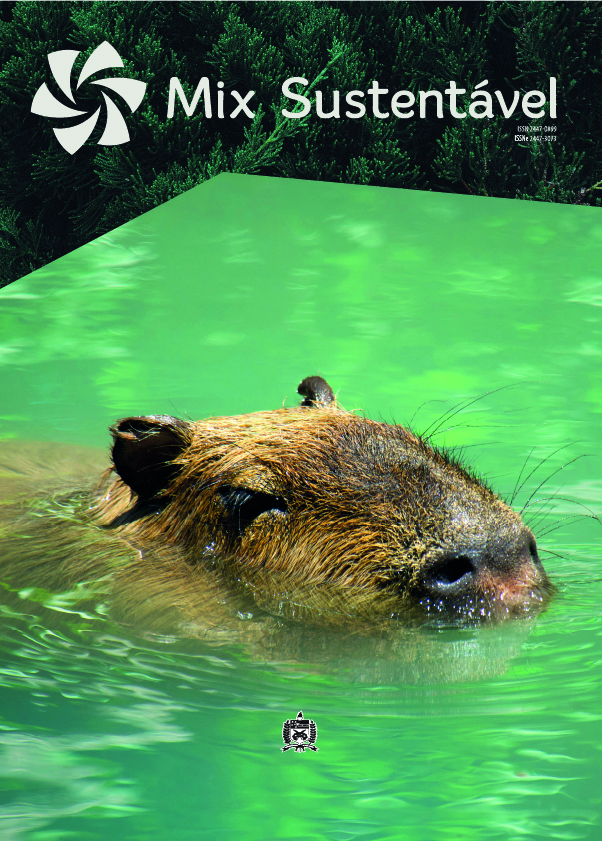MANUFATURA ADITIVA E RECICLAGEM DISTRIBUÍDA: O LIXO COMO MATÉRIA PRIMA NO DESIGN E FABRICAÇÃO DE OBJETOS UTILITÁRIOS
ADDITIVE MANUFACTURING AND DISTRIBUTED RECYCLING: WASTE AS RAW MATERIAL IN THE DESIGN AND MANUFACTURE OF UTILITARIAN OBJECTS
DOI:
https://doi.org/10.29183/2447-3073.MIX2024.v10.n1.51-61Palavras-chave:
Manufatura Aditiva, Reciclagem, Design, Design para manufatura aditiva, SustentabilidadeResumo
As primeiras décadas do século XXI testemunharam dois grandes acontecimentos: a inserção da China no mercado de fornecimento global e a popularização da Internet. Os mais diversos segmentos da indústria foram afetados por uma avalanche de ofertas e queda de preços de novas máquinas e produtos, entre eles as tecnologias de Manufatura Aditiva. Essa tecnologia permite a produção em menor escala e com valores mais baixos do que os métodos tradicionais de produção de artefatos. Essa conexão, aliada ao reaproveitamento de resíduos da produção local, pode revolucionar as cadeias de suprimentos e a circularidade no desenvolvimento e na distribuição de objetos. Este trabalho demonstra o desenvolvimento de um sistema de manufatura aditiva alinhado à reciclagem distribuída considerando seus impactos, vantagens, desvantagens e possibilidades de aplicação no cenário brasileiro, em termos de sustentabilidade e circularidade dos processos.
Referências
ANDERSON, C., (2013). Makers: The New Industrial Revolution. Random House Business, London.
MCDONOUGH, B., BRAUNGART, M. 2002, Cradle to Cradle: Remaking the Way We Make Things. ISBN-10: 0865475873.North Point Press. USA
BAUMERS, M., TUCK, C., BOURELL, D.L., SREENIVASAN, R., HAGUE, R. (2011). Sustainability of additive manufacturing: measuring the energy consumption of the laser sintering process. Proceedings of the Institution of Mechanical Engineers, Part B: Journal of Engineering Manufacture, 225(12), 2228–2239.
BAUMERS, M., TUCK, C., WILDMAN, R., ASHCROFT, I., ROSAMOND, E., HAGUE, R. (2013). Transparency Built in. Journal of Industrial Ecology, 17(3), 418–431.
BIRTCHNELL, T., & HOYLE, W. (2014). 3D Printing for Development in the Global South: The 3D4D Challenge. Basingstoke: Palgrave Macmillan.
BOGERS, M., HADAR, R., BILBERG. A. (2016). Additive manufacturing for consumer-centric business models: Implications for supply chains in consumer goods manufacturing. Technological Forecasting & Social Change, 102, 225–239.
BYARD, D. J., WOERN, A. L., OAKLEY, R. B., FIEDLER, M. J., SNABES, S. L., & PEARCE, J. M. (2019). Green Fab Lab Applications of Large-Area Waste Polymer-based Additive Manufacturing. Additive Manufacturing, 27, pp. 515-525.
CHANDLER, A.D. (1990). Scale and Scope: The Dynamics of Industrial Capitalism. Cambridge MA: Harvard University Press.
CHAVES, Luís de Gonzaga Mendes, (1971). Minorias e seu estudo no Brasil. Revista de Ciências Sociais, Fortaleza, v. 1, n. 1, p. 149-168
CHEN, D., HEYER, S., IBBOTSON, S., SALONITIS, K., STEINGRÍMSSON, J.G., Thiede, S., (2015). Direct Digital Manufacturing: Definition, Evolution, and Sustainability Implications. Journal of Cleaner Production, 107, 615–625.
DALSGAARD, Peter; HALSKOV, Kim. Reflective design documentation. In: Proceedings of the Designing Interactive Systems Conference. 2012. p. 428-437.
DESPEISSE, M., BAUMERS, M., BROWN, P., CHARNLEY, F., FORD, S. J., GARMULEWICZ, A., ROWLEY, J. (2016). Unlocking value for a circular economy through 3D printing: a research agenda. Technological Forecasting & Social Change, p. 49.
DOS SANTOS, J., BRANCAGLION JUNIOR, A., WERNER JUNIOR, H., & AZEVEDO, S. (2013). Tecnologias 3d: desvendando o passado e modelando o futuro [3d Technologies: unraveling the past and shaping the future]. Brazil: lexikon editora digital.
DOS SANTOS, J., WERNER JUNIOR, H., AZEVEDO, S., & BRANCAGLION JUNIOR, A. (2019). Seen / Unseen. Brazil: rio books.
DOS SANTOS, J. R., CORREIA DE MELO, J. V., FRAJHOF, L., & KAUFFMANN, A. R. (December de 2020). Confronting COVID-19 - The case of PPE and Medical Devices production using Digital Fabrication at PUC-Rio. SDRJ - Strategic Design Journal, p. 14.
GRAEDEL, T.E., Allenby, B.R., (2002). Industrial ecology. Prentice Hall, Englewood Cliffs, NJ, USA.
GUSMÃO, G. (2004). “Rua dos Inventos”, Invention street. A arte da sobrevivência • The art of survival. Rio de Janeiro: IBM.
ILLICH, I. (1976). A Convivencialidade. Lisboa: Publicações Europa-América.
LEARY, M. (2020). Chapter 3 - Digital design for AM. Em M. LEARY, Additive Manufacturing Materials and Technologies: Design for Additive Manufacturing (pp. 33-90). Oxford: Eselvier.
LOVINS, A.B. (1996). Negawatts: Twelve transitions, eight improvements and one distraction. Energy Policy,24(4), 331–343.
KOHTALA, C., HYYSALO, S., (2015). Anticipated environmental sustainability of personal fabrication. Journal of Cleaner Production, 99, 333–344.
KREIGER, M., ANZALONE, G., MULDER, M., GLOVER, A., & PEARCE, J. (27 de Fevereiro de 2013). Distributed Recycling of Post-Consumer Plastic Waste in Rural Areas. MRS Online Proceedings Library, 1492, 101-106.
PETERSEN, E., & PEARCE, J. (2017). Emergence of Home Manufacturing in the Developed World: Return on Investment for Open-Source 3-D Printers. (MDPI, Ed.) Technologies, 5(7), p. 15. doi:10.3390/technologies5010007
TANG, Y., & ZHAO, Y. (18 de Abril de 2016). A survey of the design methods for additive manufacturing to improve functional performance. Rapid Prototyping Journal, p. 21.
ZIMMERMAN, J., Forlizzi, J., & Evenson, S. (2007). Research through design as a method for interaction design research in HCI. Proceedings of the SIGCHI conference on Human factors in computing systems, 493-502.
Downloads
Publicado
Como Citar
Edição
Seção
Licença
Copyright (c) 2023 João Victor Correia de Melo

Este trabalho está licenciado sob uma licença Creative Commons Attribution 4.0 International License.
Aviso de Direito Autoral Creative Commons
1. Política para Periódicos de Acesso Livre
Autores que publicam nesta revista concordam com os seguintes termos:
a. Autores mantém os direitos autorais e concedem à revista o direito de primeira publicação, com o trabalho simultaneamente licenciado sob a Licença Creative Commons Attribution que permite o compartilhamento do trabalho com reconhecimento da autoria e publicação inicial nesta revista.
b. Autores têm autorização para assumir contratos adicionais separadamente, para distribuição não-exclusiva da versão do trabalho publicada nesta revista (ex.: publicar em repositório institucional ou como capítulo de livro), com reconhecimento de autoria e publicação inicial nesta revista.
c. Autores têm permissão e são estimulados a publicar e distribuir seu trabalho online (ex.: em repositórios institucionais ou na sua página pessoal) a qualquer ponto após o processo editorial, já que isso pode gerar alterações produtivas, bem como aumentar o impacto e a citação do trabalho publicado (Veja O Efeito do Acesso Livre).




